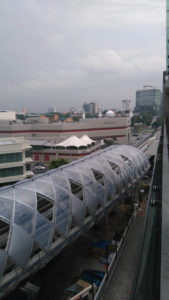 Odds are, most architects have seen the iconic Petronas Twin Towers in Kuala Lumpur, the capitol of Malaysia. Built in 1998, the Petronas towers remain the tallest twin towers in the world at 1,482 feet (452 meters). Architects are less likely to know that Kelana Jaya is a rapidly-urbanizing suburb located on the southwest edge of Kuala Lumpur. And, architecturally speaking, many designers may eventually look to the city for this striking air-borne “tunnel” that houses a segment of the LRT Kelana Jaya Line.
Odds are, most architects have seen the iconic Petronas Twin Towers in Kuala Lumpur, the capitol of Malaysia. Built in 1998, the Petronas towers remain the tallest twin towers in the world at 1,482 feet (452 meters). Architects are less likely to know that Kelana Jaya is a rapidly-urbanizing suburb located on the southwest edge of Kuala Lumpur. And, architecturally speaking, many designers may eventually look to the city for this striking air-borne “tunnel” that houses a segment of the LRT Kelana Jaya Line.
The LRT Kelana Jaya Line is part of a citywide system that is has elevated second-level stops and a handful of underground and at-grade stations. The Line weaves between buildings on its way in and out of this southern capitol city. The light rail line is part of a much larger network, the Greater KL/Klang Valley Integrated Transit System that connects Kuala Lumpur with regions to the south, including Kelana Jaya.
Considered the country’s first “tunnel in the air,” the LRT Kelana Jaya Line opened in March 2016 and displays a sophisticated structural ensemble. Overall, it comprises a cylindrical tube of diagonally crossing latticework, raised on support piers that gently bend to snake between a hotel and an apartment tower. One remarkable fact is that it has only 2.5 meters clearance on either side of the track.
The architects for the project, NEUformation Architects, Petaling Jaya, Malaysia, designed a patchwork of ETFE cushions in an alternating pattern of clear and printed cladding to break up the surface appearance, enclose the noise and shield the view of the train line from residents and pedestrians in the vicinity.
“The irregular form of the tunnel meant that no two of the 363 ETFE cushions were the same,” says Christopher Rowell, managing director of Chepstow, U.K.-based Architen Landrell, fabricators of the tunnel ETFE units. The units also varied in translucency, from clear to a heavy silver frit pattern, to lend overall interest. Every third “lozenge” of the ETFE cushions on the top side of the KJ LRT “tunnel” is open to relieve air pressure.
To meet budget and deadline expectation, Architen Landrell knew it would need to streamline its approach in fabricating the complex geometry across the full array of cushions, each unique. Rowell says, “We worked with a computer programmer to help us develop software that could output cut files and extrusion details for every single cushion.”
The project won an Outstanding Achievement Award in IFAI’s International Achievement Awards program.
Bruce N. Wright, AIA, is an architect and consultant to designers on fabric in architecture. He frequently writes about the intersection of design, architecture and textiles for Specialty Fabrics Review, Advanced Textiles Source and Fabric Architecture magazines.
 TEXTILES.ORG
TEXTILES.ORG


